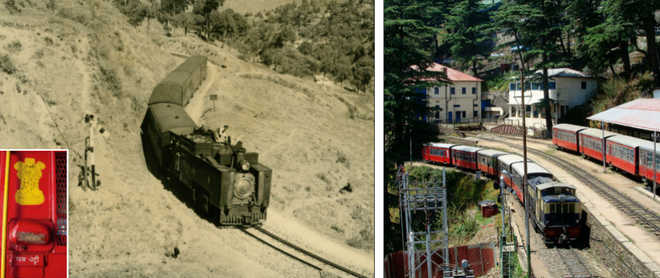
A vintage picture of the train that was an extension of the Delhi-Ambala-Kalka branch of the East Indian Railway; the Shimla Railway station; and (inset) the mail service cabin on the train.
Raaja Bhasin
The Kalka-Shimla Railway line turns 116. On November 9, 1903, with a steam locomotive pulling passenger coaches out of Kalka, the train had its first commercial run. The line was an extension of the Delhi-Ambala-Kalka branch of the East Indian Railway. At the time, this was an extraordinary feat of engineering. The track was 96.6-km long, rose from low-rolls of terrain around Kalka at 660 metres, and went past the Shivalik hills to reach Shimla at 2,075 metres.
The idea of a rail link to Shimla had been presented as early as November 1847 by a correspondent of the Delhi Gazette — this was six years before the first train whistled through the Indian subcontinent. He wrote: “We may, then see these cooler regions become the permanent seat of a government daily invigorated by a temperature adapted to refresh a European constitution, and keep the mental power in a state of health, alike beneficial to rulers and the ruled”.
On the line, initially, there were 107 tunnels and today, there are 102 — but for tradition’s sake, the line is still referred to have 103 tunnels, which was the figure through most of its life. No. 46, which was near Solan Brewery, is no longer there. There are 800 bridges and 900 curves and during its course through the picturesque countryside that characterises the lower reaches of the Himalayas, at times, the line goes through a succession of reverse curves of over 36-metre radii.
The longest tunnel at Barog is over a kilometre long. The original alignment was about half a kilometre higher up the hill and digging began from both sides of the hill. At some point, the engineers realised that the two ends were not going to meet and the digging was abandoned. The bridges that resemble Roman aqueducts are replete with building skills and the longest arch viaduct has an aggregate length of 2.8 km. The track was built by a private company under the supervision of HS Harington, Chief Engineer and Agent of Kalka-Shimla Railway. The state had purchased the Railway in 1906 and it had cost around Rs 1.71 crore at the time of its construction.
As a result of the terrain, the course of the line often had to be altered and of all the stories that are told about its construction there is none as fascinating as that of Bhalku, a common labourer. He claimed that the track that the line should take had been revealed to him by his ‘devta’ (deity). He would march with a long staff over the hills ‘listening’ to what they told him and it is said that even engineers were in awe of his ‘supernatural’ powers and always deferred to him.
Another story is connected with the Tara Devi station, which had a ‘plague inspection post’ to prevent the pestilence from reaching Shimla’s power-filled heights. Here, all passengers travelling in all classes except the first had to undergo physical fumigation and that of all their belongings before they were permitted to travel to Shimla. Later, as the freedom movement gathered momentum, the stop at Tara Devi soon came to be named ‘Aap ka naam — Baap ka naam’, as visitors had to fill a whole series of details, including their names, addresses, the address they would be staying at in Shimla and things that only heaven and the CID knew about.
In 2008, the World Heritage Committee of Unesco gave the rail line the ‘world heritage’ status saying: “The Kalka-Shimla Railway represents an exceptional technical achievement in the development of the Himalayan mountains because of its length, its altitude and the difficulty of the terrain through which it runs in difficult tropical climatic conditions”.
Punish litterers
Windows should be fitted with netting to check people throwing litter out. Each coach should be equipped with a large dustbin and severe penalties should be imposed on those littering within the train or around.
(The writer is an author, historian and journalist)



























